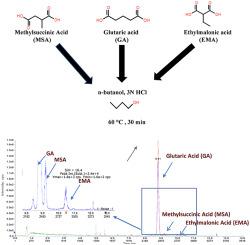Analytical Biochemistry Pub Date : 2022-02-23 , DOI: 10.1016/j.ab.2022.114604 Kuan-Wei Peng 1 , Allison Klotz 1 , Arcan Guven 1 , Kayleigh Gray 1 , Tracey Friss 1 , Shobha Ravipaty 1 , Rangaprasad Sarangarajan 1 , Vladimir Tolstikov 1 , Mark D Kellogg 2 , Niven R Narain 1 , Michael A Kiebish 1

|
Low molecular-mass aliphatic carboxylic acids are critically important for intermediate metabolism and may serve as important biomarkers for metabolic homeostasis. Here in, we focused on multiplexed method development of aliphatic carboxylic analytes, including methylsuccinic acid (MSA), ethylmalonic acid (EMA), and glutaric acid (GA). Also assessed was their utility in a population's health as well as metabolic disease screening in both plasma and urine matrices. MSA, EMA, and GA are constitutional isomers of dicarboxylic acid with high polarity and poor ionization efficiency, resulting in such challenges as poor signal intensity and retention, particularly in reversed-phase liquid chromatography with electrospray mass spectrometry (RP-LC-ESI-MS/MS). Derivatization using n-butanol was performed in the sample preparation to enhance the signal intensity accompanied with a positive charge from ionization in complicated biomatrices as well as to improve the separation of these isomers with optimal retention. Fit-for-purpose method validation results demonstrated quantitative ranges for MSA/EMA/GA from 5/10/20 ng/mL to 400 ng/mL in plasma analysis, and 100/200/100 ng/mL to 5000/10000/5000 ng/mL in urine analysis. This validated method demonstrates future utility when exploring population health analysis and biomarker development in metabolic diseases.
中文翻译:

对血浆和尿液中的甲基琥珀酸、乙基丙二酸和戊二酸进行多重 LC-MS/MS 分析
低分子量脂肪族羧酸对中间代谢至关重要,可作为代谢稳态的重要生物标志物。在这里,我们专注于脂肪族羧酸分析物的多重方法开发,包括甲基琥珀酸 (MSA)、乙基丙二酸 (EMA) 和戊二酸 (GA)。还评估了它们在人群健康中的效用以及血浆和尿液基质中的代谢疾病筛查。MSA、EMA 和 GA 是二羧酸的结构异构体,具有高极性和差的电离效率,导致信号强度和保留差等挑战,特别是在反相液相色谱和电喷雾质谱 (RP-LC-ESI-MS /多发性硬化症)。在样品制备过程中使用正丁醇进行衍生化以增强信号强度以及复杂生物基质中电离产生的正电荷,并以最佳保留改善这些异构体的分离。适合用途的方法验证结果表明,血浆分析中 MSA/EMA/GA 的定量范围为 5/10/20 ng/mL 至 400 ng/mL,以及 100/200/100 ng/mL 至 5000/10000/5000尿液分析中的 ng/mL。这种经过验证的方法在探索代谢疾病中的人口健康分析和生物标志物开发时展示了未来的实用性。适合用途的方法验证结果表明,血浆分析中 MSA/EMA/GA 的定量范围为 5/10/20 ng/mL 至 400 ng/mL,以及 100/200/100 ng/mL 至 5000/10000/5000尿液分析中的 ng/mL。这种经过验证的方法在探索代谢疾病中的人口健康分析和生物标志物开发时展示了未来的实用性。适合用途的方法验证结果表明,血浆分析中 MSA/EMA/GA 的定量范围为 5/10/20 ng/mL 至 400 ng/mL,以及 100/200/100 ng/mL 至 5000/10000/5000尿液分析中的 ng/mL。这种经过验证的方法在探索代谢疾病中的人口健康分析和生物标志物开发时展示了未来的实用性。






























 京公网安备 11010802027423号
京公网安备 11010802027423号